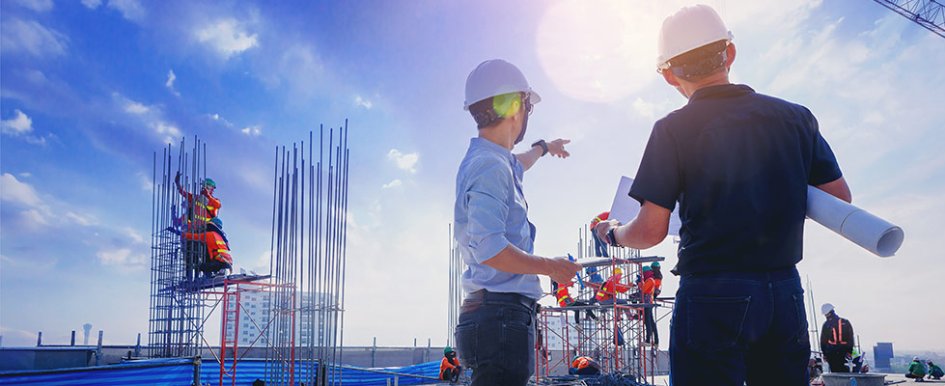
The construction industry has transformed in recent years, propelled by technological advancements that have significantly optimized workforce demand. The use of cutting-edge construction equipment and innovative technology has reshaped the way projects are planned, executed and completed. What’s more, modern construction equipment and technology streamlines processes, enhances efficiency and maximizes the utilization of the workforce.
Digital Twin Technology
Digital twin technology has significantly changed the construction industry. With the technology providing a virtual representation of a physical asset — such as a building, infrastructure or construction project — that mirrors its real-world counterpart in a digital environment, construction planning is more efficient, leading to a reduction in the demand on the construction workforce.
The virtual planning and simulation process enables teams to identify potential issues or inefficiencies in the design phase. By addressing these issues first in the digital environment, costly rework and delays during the construction phase are minimized, resulting in a smoother, better optimized construction process.
In addition, the virtual twin serves as a central platform where all stakeholders can review and provide input on the project. The real-time data and collaborative approach streamlines decision-making and minimizes the risk of miscommunication that often leads to additional rework or adjustments in the field. What adds to its value for construction teams is its capacity to track various scenarios, enhancing the allocation of the workforce and optimizing production. The simulations prove particularly beneficial for evaluating potential risks and safety hazards, and in bolstering enhanced planning. Identifying risks ahead of time allows for the proper proactive measures to be put in place and reduces the occurrence of accidents.
Drones & Aerial Imaging
Drones have become increasingly prevalent on construction sites, with their utilization extending from preconstruction phases to project monitoring, safety inspections, thermal imaging and even the incorporation of laser-scanned aerial point clouds. These versatile tools now provide indispensable perspectives and insights throughout various stages of a project. The utilization of real-time data, coupled with newer AI-assisted tools, empowers project managers and stakeholders to oversee construction progress, manage material stockpiles and swiftly identify potential issues.
Manual site inspections are time consuming and resource intensive. In a matter of minutes, a safety professional can inspect a multistory building, or a thermographer can identify any inefficient areas where cool air or heat is leaking. By quickly surveying jobsites and analyzing the data through aerial drone point-cloud scanning, design and construction crews can efficiently work to address any challenges — resulting in a more seamless workflow and revolutionizing the precision and efficiency of site assessment processes.
Modernized Heavy Equipment
There are standard pieces of equipment on jobsites that need to move dirt or lift heavy beams. However, the advancement in more specialized equipment allows for workers to more efficiently build, move through the jobsite and work safely.
Such technology was used on the Civic Park project in San Antonio, Texas, a public, 9-acre park featuring five springs (or shallow pools) constructed of unique cubic stones. In order to install the 1,200 pieces of limestone used for the pools within the tolerances required, the masonry subcontractor (Shadrock & Williams Masonry) had to move each stone as efficiently as possible. To that end, the mason coordinated with the on-site Skanska team and used a Pegasus 360-degree telehandler. With its lifting capacity and extended reach capabilities, the telehandler was able to handle heavier loads and cover a larger area on the construction site, which eliminated the need for multiple cranes and more labor-intensive methods of moving the large stones, while optimizing workforce labor demands. This resulted in a more efficient process and one that minimized the logistical impact on the site.
Telematics & Equipment Tracking
Large pieces of equipment will never be replaced on a jobsite, but how they are maintained is making great strides. Telematics technology has become a keystone of equipment management. Many pieces of construction equipment have sensors and GPS tracking systems that provide real-time data on equipment location, usage and maintenance needs. This data-driven approach to equipment management minimizes downtime caused by equipment breakdowns and prevents the overuse of certain machines while others remain underutilized. As a result, the workforce is also better used, as projects can proceed without unnecessary interruptions due to equipment-related issues.
Prefabrication & Modular Construction
Prefabrication and modular construction have redefined the traditional construction approach on projects large and small, offering enhanced efficiency and precision. The creation of prefabricated components off-site not only significantly reduces on-site labor, thereby decreasing the labor demand on the project, but also improves safety by minimizing the need for certain on-site construction activities.
The precision found in the prefabrication process mitigates human error and potential reworks because each component fits together seamlessly. As this approach becomes more popular, clients find the construction timeline is reduced and it results in a quality product. The workforce is used more efficiently during these builds since they focus on assembling and integrating components rather than performing labor-intensive tasks. Prefabricating multi-trade hangers brings distinct advantages to congested areas above hallways and near mechanical rooms of a construction project, streamlining installation processes and optimizing spatial efficiency while ensuring seamless installation among various trades.
The interaction between traditional construction equipment/processes and innovative technology has opened an era of efficiency and optimization in construction. These advanced tools and equipment reduce the demand on the workforce, which allows them to efficiently move through the jobsite. Project timelines are accelerated, worker safety is enhanced, errors are reduced and more accurate information is shared among teams with these developments.
It is critical to note that, while modern equipment and technology makes for a more efficient workplace, human expertise is irreplaceable. Skilled workers are needed to operate, manage and oversee this equipment and technologies, which helps ensure a smooth integration into the construction process. As construction equipment and technology continue to evolve, the construction industry will continue its transformation and welcome innovation for years to come.
